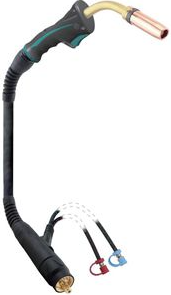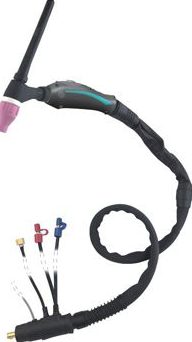Welding guns are essential tools in the welding process, enabling the joining of metal pieces through the application of heat and, sometimes, filler material. There are different types of welding guns, each suited for specific welding techniques, including MIG (Metal Inert Gas), TIG (Tungsten Inert Gas), and stick welding. Here’s an overview of how a welding gun works, focusing on the MIG welding gun as an example.
1. Understanding the Welding Gun Components
A typical welding gun consists of several key components:
MIG Welding Gun: The primary tool that directs the electrode wire, shielding gas, and electrical current to the weld area.
Electrode Wire: A consumable wire that serves as the filler material, which is melted and deposited into the weld joint.
Nozzle: Directs the shielding gas to the weld area to protect the molten weld pool from atmospheric contamination.
Contact Tip: Transfers the electrical current to the electrode wire, enabling it to melt and fuse the metal pieces together.
Trigger: Activates the flow of electrode wire, electrical current, and shielding gas when pressed.

MIG Welding Gun
2. How the Welding Gun Functions
The operation of a MIG welding gun involves several steps:
Feeding the Wire: When the welder presses the trigger, the wire feed mechanism pushes the electrode wire through the contact tip and out of the nozzle. The speed of the wire feed can be adjusted based on the welding requirements.
Shielding Gas Flow: Simultaneously, the shielding gas (commonly argon or a mix of argon and carbon dioxide) flows through the nozzle to the weld area. This gas forms a protective shield around the molten weld pool, preventing oxidation and contamination from the surrounding air.
Electrical Arc Formation: As the electrode wire comes into contact with the workpiece, an electrical circuit is completed, creating an arc between the wire and the metal surface. The heat generated by this arc melts the electrode wire and the base metal, forming a molten pool.
Weld Pool Creation: The molten pool consists of the melted electrode wire and the base metal. The welder moves the gun along the joint, allowing the molten pool to fill the gap between the metal pieces and solidify, forming a strong weld bead.
3. Types of Welding Guns and Their Specific Functions
Different welding guns are designed for specific welding techniques:
MIG Welding Gun: Used for continuous wire feed welding, ideal for welding thicker materials and providing a consistent weld bead.
TIG Welding Gun: Utilizes a non-consumable tungsten electrode and is often used for precision welding of thinner materials. It allows for greater control over the weld pool and is ideal for stainless steel and aluminum.
Stick Welding Gun: Uses a consumable electrode stick. This method is versatile and can be used in various environments, including outdoor settings and on rusty or dirty metals.

TIG Welding Gun
4. Advantages of Using Welding Guns
Welding guns offer several benefits:
Efficiency: They provide a continuous and controlled feed of electrode wire, increasing welding speed and efficiency.
Precision: The welder can precisely control the weld pool and bead formation, resulting in high-quality welds.
Versatility: Different welding guns are available for various applications, from heavy industrial welding to delicate, precise work.
Questions and Answers
Q: What type of welding gun is best for beginners?
A: MIG welding guns are often recommended for beginners due to their ease of use, continuous wire feed, and ability to weld a variety of metals with minimal spatter.
Q: How do I maintain my welding gun?
A: Regular maintenance includes cleaning the nozzle and contact tip, inspecting the wire feed mechanism, and checking for any wear or damage. Keeping the gun components clean and in good condition ensures optimal performance and longevity.
Q: Can I use the same welding gun for different types of welding?
A: Some welding guns are versatile and can be adapted for different welding processes with the appropriate attachments and settings. However, it's generally best to use a gun specifically designed for the welding method you are employing to ensure the best results.
In summary, welding guns are vital tools that facilitate the welding process by providing a controlled and efficient means of delivering the electrode wire, shielding gas, and electrical current to the weld area. Understanding the components and functions of a welding gun can help you achieve high-quality welds and enhance your overall welding experience.
To see all of our welding guns options online, click here.









